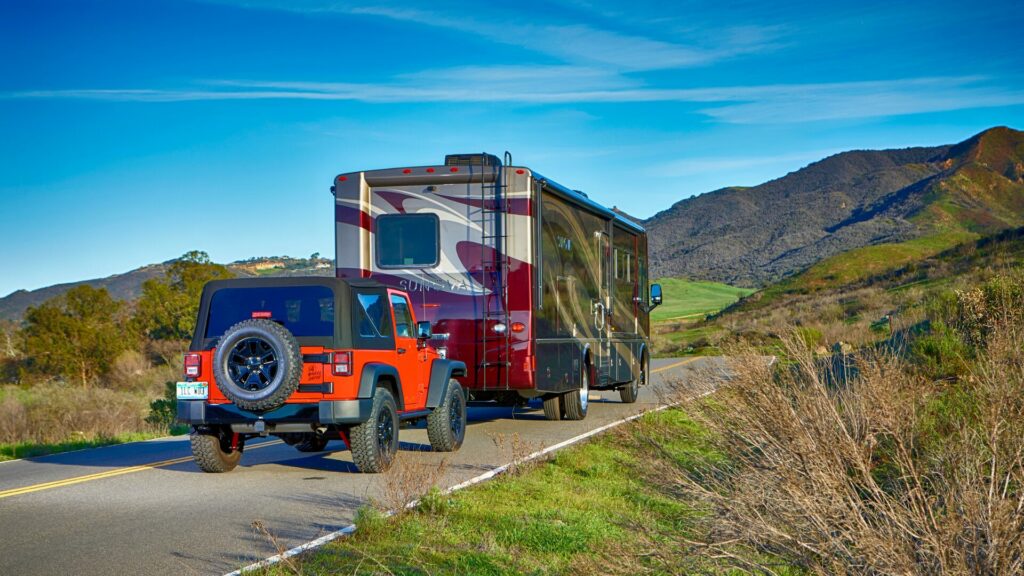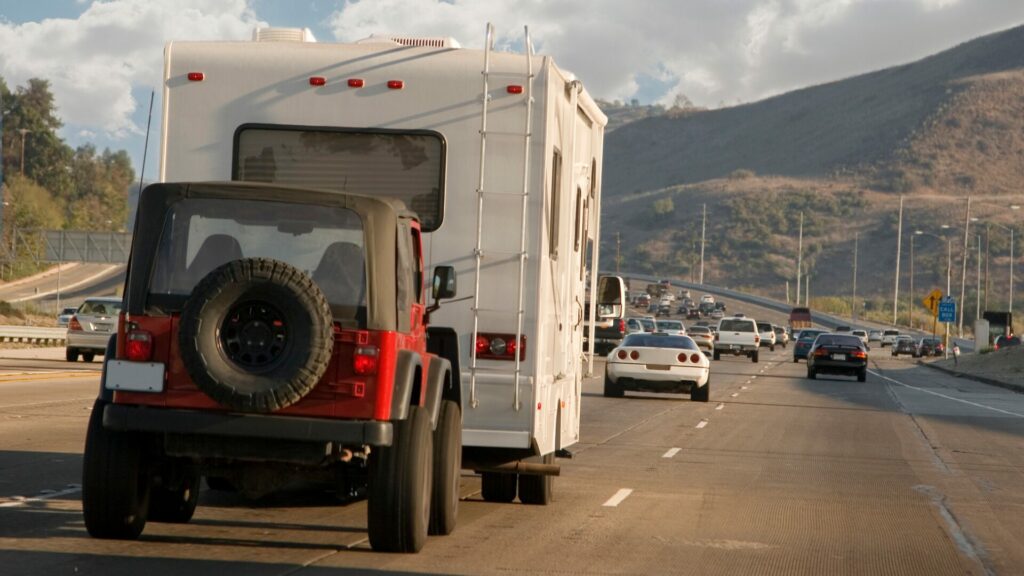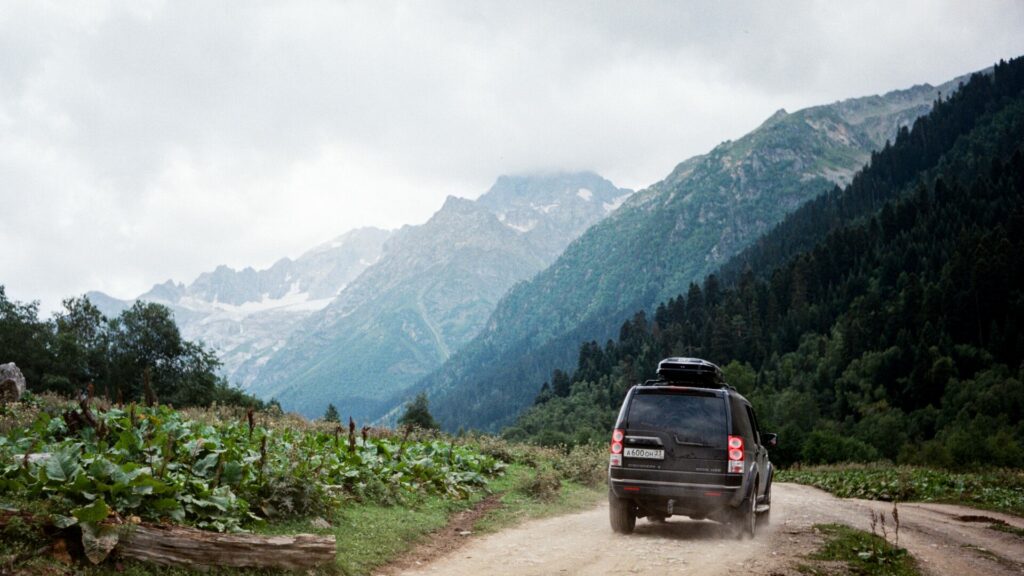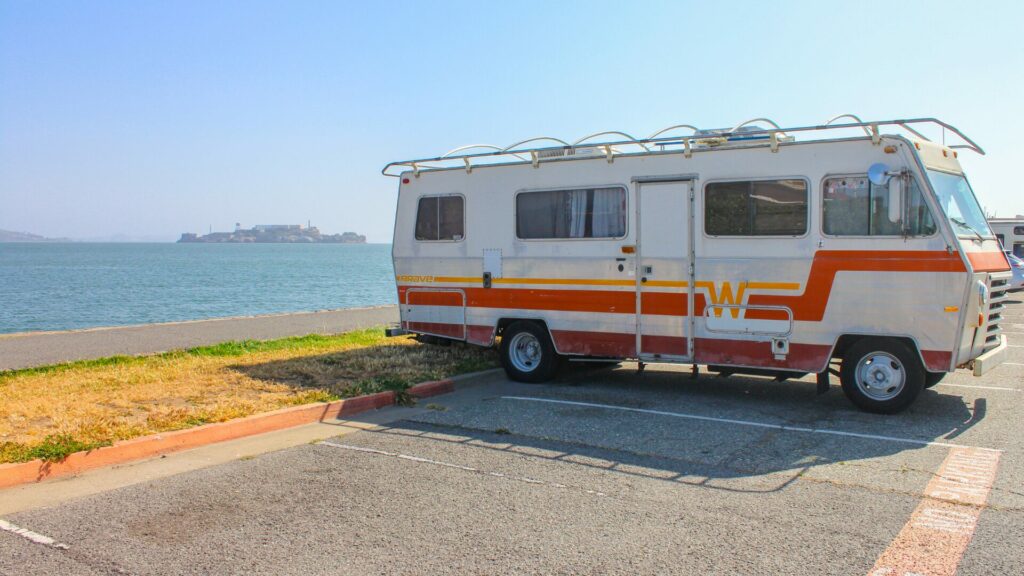Table of Contents Show
When it comes to RVing, many people choose convenience over cost. Perhaps it’s choosing a more expensive campground 30 minutes closer to a national park. Maybe it’s buying an RV with a washer and dryer rather than saving a few thousand dollars on a different model.
For motorhome owners, having a toad car is one of those conveniences. Today, we’re considering the pros and cons of towing a second vehicle. Do you think the advantages outweigh the challenges? Let’s dive in and find out!
What Is A Toad Car?
A toad car is the vehicle motorhome owners tow behind their RV. It’s also referred to as a “dinghy.” Class As and Class Cs can be 40+ feet long, making it difficult to navigate around a grocery store parking lot or a national park visitor center parking lot. Having a second vehicle allows these RVers to explore with more freedom. Therefore, large motorhome owners will typically have a toad car.
Pro Tip: Check out this article on whether or not you Can Flat Tow a Tesla Behind a Motorhome before setting off on your next trek with the car!
What Types Of RVs Can Have A Toad Car?
Most motorized RVs have the towing capacity to haul a vehicle. But each unit will have its own specs. We’ll talk more about that in a minute. Generally, owners of fifth wheels and travel trailers don’t have toad cars because they already have a vehicle that unhooks from the camper. Triple towing is also unlawful in many states. Consequently, you’ll usually see toad cars attached to Class As and Class Cs, not towable RVs.

What Are the Different Towing Capacities Of Motorhomes?
Generally, Class As will have the highest towing capacities of any motorized RV. They can haul anywhere from 10,000 to 15,000 pounds, although this varies from model to model and depends on the engine size.
Super Cs are also capable of hauling heavier vehicles. In fact, due to their heavy-duty Ford F-550 chassis and diesel engines, these beasts can tow up to 25,000 pounds. But this is a much smaller category than Class As. You don’t see nearly as many Super Cs on the road as Class As.
Class Cs are usually smaller than Class As and have a smaller towing capacity ranging from 5,000 to 8,000 pounds. Class B camper vans will have the least towing capacity, approximately 3,500 to 5,000 pounds, but it’s still adequate for a small sedan.
What Are the Different Towing Methods For A Toad Car?
RVers can choose from a few different methods to tow their toad cars. It’s personal preference most often. If you don’t want to deal with heavy equipment, you flat tow if possible. If you don’t have a vehicle that can be flat towed, you don’t have an option but to choose a tow dolly or trailer. Let’s briefly look at each method of towing a toad car.
Tow Dolly
A tow dolly raises the front two tires off the road. It’s a smaller piece of equipment than a trailer, thus requiring less storage space at a campsite. A tow dolly attaches to the rear hitch of a motorhome. Because the two rear tires remain on the road, you can’t tow a rear-wheel drive vehicle this way unless you disconnect the driveshaft.
Trailer
If you have a rear-wheel drive vehicle, your only option may be to buy a trailer. Depending on preference and budget, this could be an enclosed or flatbed trailer. Some RVers want to protect their toad car from the weather, so they choose an enclosed trailer. Others don’t want the hassle of finding storage space for an enclosed trailer when it’s not in use.
Regardless of your choice, a trailer is a much larger piece of equipment than a tow dolly. It also attaches to the rear hitch of a motorhome. But it will add significantly more weight, which means it may limit the size of the toad car to stay under the motorhome’s towing capacity. With a trailer, all four tires of the toad car are raised off the ground. This method reduces the wear and tear of travel on the second vehicle.
Flat Tow
Finally, if you’ve seen a toad car with all four wheels on the road, then the owners are flat towing. Because of this, only certain vehicles can be flat towed. Since the wheels turn without the car running, you can severely damage your vehicle’s transmission if you pull a vehicle that isn’t AWD or four-by-four. It would help if you had a transmission disconnect and steering lockout override to safely flat tow a car.
You don’t need large equipment for flat towing, but you need certain products like a tow bar and base plate. The tow bar attaches to the motorhome’s hitch, and the base plate connects to the toad car.

What Are the Pros Of Bringing A Toad Car?
So why do people bring a toad car? It may seem like too much of a hassle to hitch and unhitch a second vehicle. Let’s look at the advantages of having a toad car when traveling.
Freedom To Explore
As we mentioned, going to the grocery store in a large motorhome isn’t easy. Not only are parking spots too small, but turning around and leaving the parking lot can be challenging. Some roads in national parks are closed to vehicles over certain lengths and heights. With a toad car, RVers can explore anywhere without worrying about restrictions.

Better Fuel Economy
Driving a Jeep Cherokee is much better on the pocketbook than driving a diesel motorhome. Some RVers tow electric vehicles, which are even more efficient. If you’re planning on doing a lot of exploring or are visiting an area for an extended period, you’ll spend a lot less at the pump with a smaller vehicle.
Emergency Vehicle
Finally, although no one wants a breakdown, a toad car provides an emergency vehicle. Unfortunately, things happen when RVing. If you have mechanical problems on a drive day, you’ll appreciate having a second vehicle to get you to a hotel. Otherwise, you’ll call an Uber or rent a car, which can be expensive if you’re without your RV for several days or weeks.
What Are the Cons Of Bringing A Toad Car?
Even though there are pros to a toad car, there are also significant disadvantages. We actually think there are more reasons not to have a toad car. But we also believe the pros outweigh the cons. Let’s look more closely at these disadvantages.
Expensive To Set-Up
As you can imagine, buying a trailer, tow dolly, or flat towing gear is expensive. Modifications to your vehicle in preparation for flat towing are also costly. You might spend $3,000-4,000 on a dolly or $1,500 to set up your car for flat towing. So, the upfront cost will negate any fuel savings for a while.
Takes Time To Hitch And Unhitch
Setting up and tearing down at a campsite is one of the least fun things about RVing. We enjoy getting to new places but hate having to get set up. When you add a toad car, it’s just something else to deal with. It takes time to hitch and unhitch at every location. Even if it’s just a few minutes, it’s still another chore.
Can’t Back Up
You can’t reverse when you have a toad car. Most campgrounds will tell motorhome owners to pull over to the side and unhook the toad car before proceeding to a back-in campsite. If you ever need to turn around in a parking lot or street because of a wrong turn or detour, you can’t do it unless you unhitch the toad car.

Longer And Heavier
Adding a vehicle to the rear of your motorhome adds overall length and weight. This can make it more challenging to drive, turn, and brake. Your stopping distance needs to increase because you’re adding several thousand pounds. Your turning radius also changes when you have a toad car. Thus, adding a toad car can make the driving experience more stressful.
Takes Up Campsite Space
Finally, the tow dolly, trailer, and other equipment occupy space. If you’re staying at a campground with narrow sites, you may be unable to store a dolly or trailer at your campsite. You may be required to take it to an overflow parking area. If you can keep it at your site, you’ve lost valuable outdoor space.
Weighing the Pros And Cons Of A Toad Car: Is It Worth It?
Even though there are more disadvantages to having a toad car, we think the pros are worth it if you travel often. We don’t suggest towing a second vehicle if you’re only taking a weekend trip here and there. It’s not worth the hassle.
But if you’re making long road trips or traveling for months at a time, we highly recommend bringing a toad car. You’ll have greater freedom to explore, which is why you’re RVing in the first place, right?
Do you travel with a toad car?






